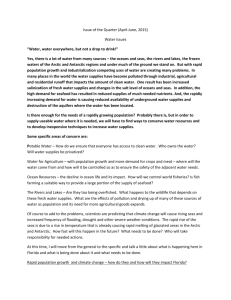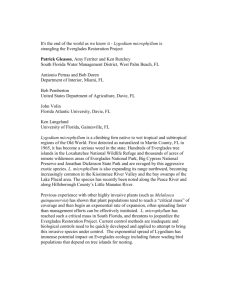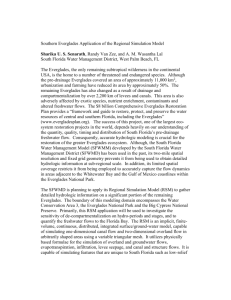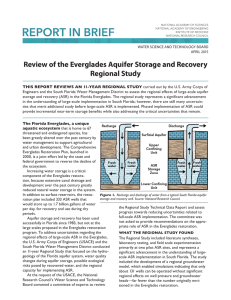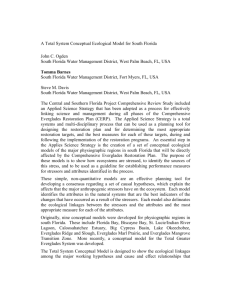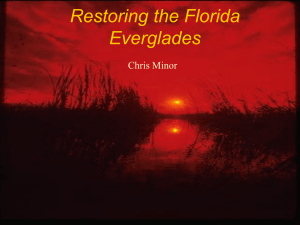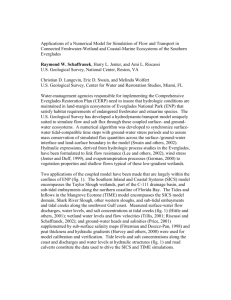Aquifer Storage and Recovery: The Solution to South Florida`s Water
advertisement
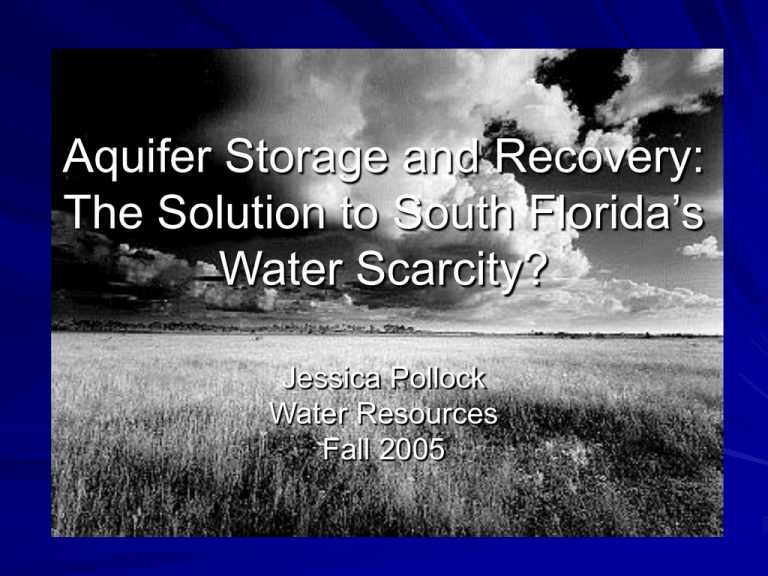
Aquifer Storage and Recovery: The Solution to South Florida’s Water Scarcity? Jessica Pollock Water Resources Fall 2005 Why need for ASR? Everyday, 1.7 billion gallons of water are diverted from the Everglades and drained off both east and west coasts This water historically flowed through the Everglades recharging the Biscayne and Floridan Aquifers Not enough water for domestic/municipal, agricultural, and ecosystem Why? continued South Florida population expected to double within 40 years ASR does not require large land acreage, as does water storage areas Ecosystems suffer – Florida Bay, Everglades, saline coastline environments What is ASR? Treatment of water to drinking standards Pumping of water into Floridan Aquifer Later recovery of stored water Has been used in Florida since 1983 Will take 20 years to complete Will be largest ASR project in world Floridan Aquifer has natural salty brine Freshwater pumped into aquifer will have zone of mixing Freshwater will create a “bubble” Plans Water from ‘wet season’ is to be stored for further usage in ‘dry season’ – also tourist season Water storage is planned for multi-year usage Wells capacity of 5 MGD to equal 1.6 to 1.7 billion GD pumping capacity Largest ASR project ever undertaken 3 pilot projects currently ongoing since 2000 Pilot projects will continue until 2008 If results successful, larger construction will take place Concerns Comprehensive Everglades Restoration Plan (CERP) relies heavily on ASR success for restoration CERP expects 70% recovery rate, may be too optimistic 5 MGD wells – 2 to 5 times higher than currently used in Florida Physical and Chemical properties should be expected to vary at each site – water as well Concerns East coast wells seem more productive than West coast wells Treated water injected into natural brine – chemical interactions, potential release? Will water be potable when recovered? Multi-year use has never been done in FL Fractured bedrock Regional changes in flow patterns DIW of wastewater Advantages Acts as above ground reservoir, without the evaporation Requires less land More Advantages Natural Aquifers – natural surface water recharges Will allow for more steady flow in Everglades – species rebound? More environmentally sound and cost effective than alternatives Will provide flood protection after many ACOE provisions taken out The “New” Everglades The Everglades Restoration is a “microcosm of the entire environmental movement.” - largest ASR project in the world -largest constructed wetland in the world Sources: “Comprehensive Everglades Restoration Plan Aquifer Storage and Recovery Program.” Everglades Plan. 6 December 2005. <http://www.evergladesplan.org/ facts_info/syutkma_asr.cfm> Dugger, Aubrey. “The South Florida Everglades Restoration Project.” 1996. 31 Oct 2001. <http://www.ce.utexas.edu/prof/maidment/ grad/degger/GLADES/glades.html> “Large-scale Ecosystem Restoration Initiatives: Protecting and Restoring the South Florida Everglades.” Northeast Midwest Institute. 02 Oct 2005. <http://www.nemw.org/everglades.htm> “Review of Aquifer Storage and Recovery in the Floridan Aquifer System of Southern Florida.” United States Geological Survey. 2004. 6 December 2005. <http://pubs.usgs.gov/fs/2004/3128/pdf/fs-2004-3128-Reese.pdf> U.S. Army Corps of Engineers, Jacksonville District; South Florida Water Management District. “Environmental and Economical Equity Program Management Plan: Comprehensive Everglades Restoration Plan.” August 2001. 20 Oct 2005. <www.evergladesplan.org/pm/ pm_docs/eee/exec_summary_aug2001.pdf>
